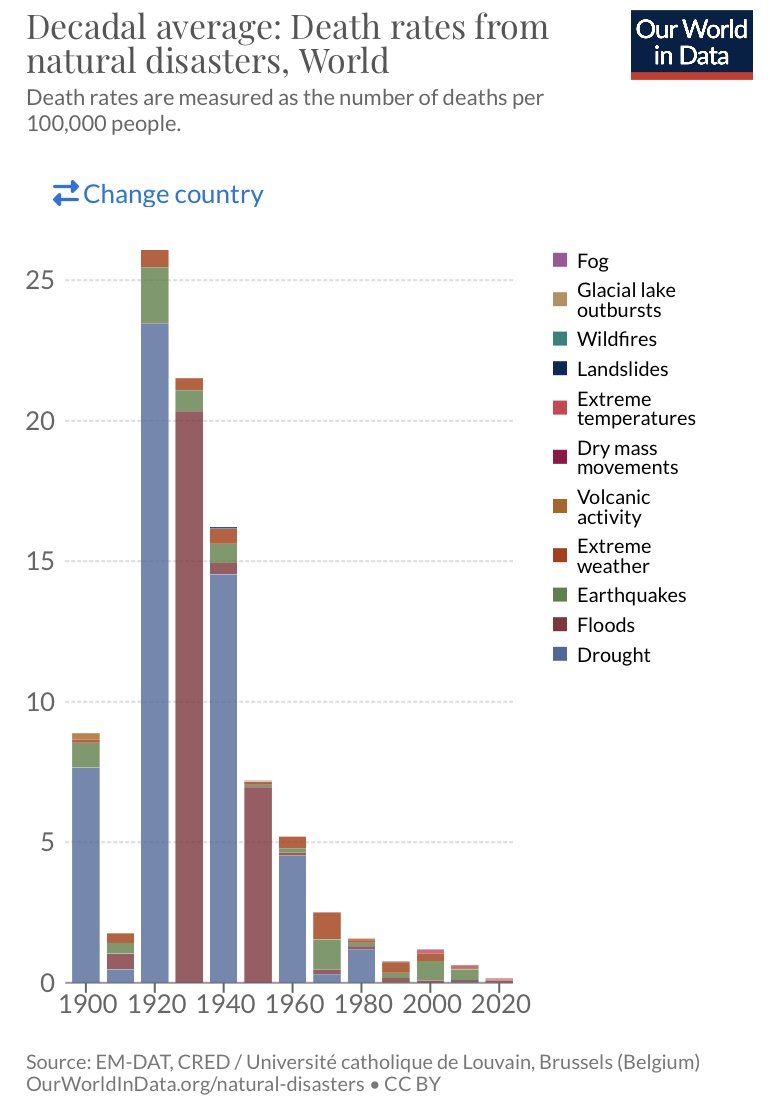Climate change is one of the biggest challenges facing humanity. Yet, I recently saw some information published by Our World in Data which made me more hopeful about our ability to adapt to the changing climate.
Why do we need to adapt?
Climate change is having a significant impact on the frequency and intensity of natural disasters around the world.
The effects of climate change, such as rising temperatures, sea level rise, and increased precipitation, are leading to more frequent and severe natural disasters, such as floods, droughts, and hurricanes.
The frequency and intensity of extreme weather events is projected to increase as the planet continues to warm [1].
Warmer temperatures can lead to more intense heatwaves and droughts, which can lead to increased risk of wildfires.
Sea level rises caused by the melting of ice sheets and glaciers can lead to more severe coastal flooding during storm surges.
Warmer oceans can lead to more intense hurricanes, as the warmer water provides more energy for these storms to develop.
All of these natural hazards impact the built environment, our homes, our work, how we travel, and pretty much every aspect of our lives.
The climate is changing and we need to adapt.
Man made climate problems
Human activities are responsible for the majority of warming since the mid-20th century [2]. The burning of carbon intense fossil fuels (coal, oil, gas) releases greenhouse gases into the atmosphere, which trap heat and cause the planet to warm.
This warming is causing the climate to change, leading to the increased frequency and intensity of natural disasters.
To be human is to adapt
The story of human civilisation is one of humans adapting their environment.
Humans built shelters to protect themselves from the elements, developed agriculture to tame vegetation to produce food, and created systems for transportation and communication.
Throughout history, human civilization has grown and changed as people have adapted their environment to suit their needs. We have transformed the natural environment to create cities and towns, built infrastructure such as roads and bridges, and developed systems for governance and social organization.
All these changes to the built environment around us allowed for the growth of human population and the development of complex societies that have shaped the world we know today.
And so it follows that we would adapt our civil infrastructure and the built environment to cope with the increasing natural disasters caused by climate change.
We’ve been building stronger and more resilient structures, such as buildings, bridges, and infrastructure that can withstand extreme weather events and rising sea levels. We use more durable building materials, such as steel and reinforced concrete, as well as building codes and regulations that require structures to meet certain standards for strength and resilience.
We’ve created green spaces and natural areas, such as wetlands and forests, that can absorb and slow down water during heavy rainfall and storms, reducing the risk of flooding. This green infrastructure, includes everything from massive constructed wetlands, down to local sustainable urban drainage systems (I’m a big fan of SUDS) like making our driveways from permeable materials.
Local and regional governments have created early warning systems and emergency response plans to help communities prepare for and respond to natural disasters. This may include things like weather monitoring and forecast systems, evacuation plans, and emergency shelters.
In coastal areas, seawalls, dikes, and other coastal defenses have been constructed to protect against sea level rise and storm surges. These structures can be built to be higher, stronger and more resilient to withstand the increasing intensity of storms and waves.
Adaption successful!
And so the data would suggest that humanity is successfully adapting to cope with natural disasters caused by climate change. Despite the global population increasing from 1.6 Bn in 1900 to 7.8 Bn in 2020, and despite the continuing worsening of our climate, it would seem that we are better able than ever to cope with the impacts of natural disasters with far fewer deaths due to natural disasters. [5].
Climate problems require climate solutions
Just because we are adapting, it doesn’t meant we shouldn’t try to limit or reverse human impact on the climate.
As the climate changes, natural hazards will become ever more extreme. This will require more resource intensive mitigations that will be more expensive. If allowed to continue, the changing climate will overwhelm our ability to adapt. The poorest nations will feel this effect first but eventually all of humanity will be impacted.
In the first instance it is absolutely essential to reduce greenhouse gas emissions and transition to cleaner sources of energy.
References:
Intergovernmental Panel on Climate Change (IPCC), https://www.ipcc.ch/
United Nations Framework Convention on Climate Change (UNFCCC), https://unfccc.int/
"Climate change, natural disasters, and adaptation" by the Environmental Defense Fund https://www.edf.org/climate/climate-change-natural-disasters-and-adaptation
"Climate change and extreme weather events" by the National Oceanic and Atmospheric Administration (NOAA) https://www.climate.gov/news-features/understanding-climate/climate-change-extreme-weather
“Decadal average death rates (world) from 1900 to 2020” Our World in Data https://ourworldindata.org/grapher/decadal-average-death-rates-from-natural-disasters?country=~OWID_WRL
Urban Drainage, Second Edition, David Butler and John W. Davies (2004)

